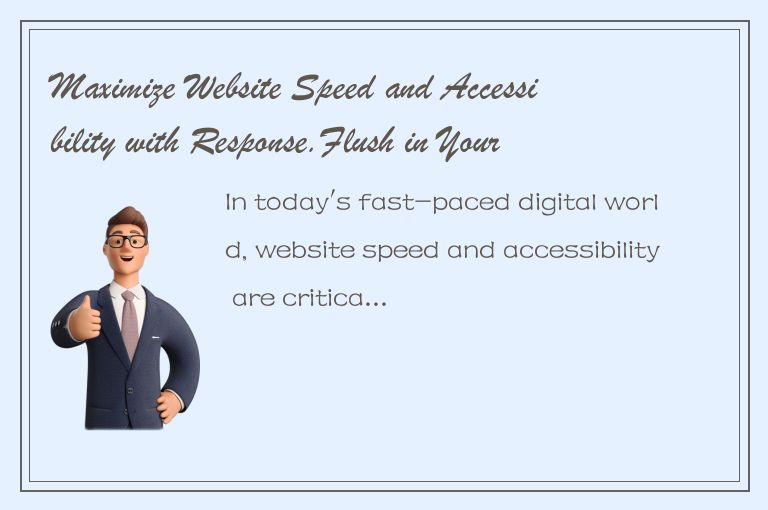In today's fast-paced digital world, website speed and accessibility are critical to the success of any online business. Users expect a fast-loading, responsive, and visually appealing website that provides seamless navigation and easy access to information. However, achieving these goals can be challenging, especially if your website relies on large files, complex design elements, or slow third-party integrations.

One effective technique for improving website speed and accessibility is using the "Response.Flush" method in your code. This technique allows you to send partial or incremental data from the server to the client as it becomes available, instead of waiting for the entire page to render before sending it to the user. Let's dive deeper into the benefits and applications of Response.Flush in website development.
How Response.Flush Works
When a user requests a web page, the server processes the request, retrieves the relevant data from the database and generates the HTML code for the page. By default, the server sends the entire page (including headers, content, and footer) to the client in one large response package, which can take significant time and bandwidth to load. This can lead to slower page load times, increased server load, and poor user experience.
Response.Flush, on the other hand, allows developers to send partial or incremental data to the client as it becomes available, effectively breaking the response into smaller, manageable chunks. This technique not only speeds up the page loading process but also enables developers to optimize the content for accessibility and SEO purposes.
Benefits of Using Response.Flush
There are several benefits to using Response.Flush in your website development, including:
1. Faster page load times
Response.Flush enables you to send partial data to the client as it becomes available, reducing the amount of time needed to load the entire page. This results in faster page load times, which can lead to better user engagement, increased conversions, and improved search engine rankings.
2. Improved server performance
By sending partial data using Response.Flush, the server can process and send the data in smaller, more manageable chunks. This reduces the load on the server, resulting in improved performance and decreased server downtime.
3. Enhanced user experience
A faster-loading website with seamless navigation and easy access to information provides a better user experience. Response.Flush helps ensure that your website visitors get a smooth and uninterrupted browsing experience, regardless of their network speed or device specifications.
4. Accessibility compliance
Web accessibility is a critical aspect of website development, as it ensures that all users, including those with disabilities, can access and use your website. Response.Flush allows you to optimize your content for accessibility by ensuring that the essential information and functionality of the page are available as soon as possible.
Applications of Response.Flush
There are several applications of Response.Flush and related techniques that can help developers enhance their website speed and accessibility. Some of these include:
1. Streaming videos and other multimedia content
Response.Flush can be used to stream videos and other multimedia content by sending the data in incremental chunks. This ensures that the video starts playing as quickly as possible, reducing buffering and lag time.
2. Dynamic and interactive web pages
Web pages that include dynamic and interactive elements, such as live chat, real-time updates, or interactive forms, can benefit from using Response.Flush to send partial data back to the client in real-time. This helps ensure that users get a seamless and responsive experience.
3. Progressive web applications
Progressive web applications (PWAs) are web applications that provide an app-like experience to users, with features such as offline caching, push notifications, and native app integrations. Response.Flush can be used to optimize PWAs by sending partial data as needed, reducing the loading time and enhancing the user experience.
Conclusion
Response.Flush is a powerful and flexible technique that can help developers improve their website speed, performance, and accessibility. By breaking down the response into smaller chunks, developers can optimize the content for better user experience, faster page load times, and improved SEO rankings. If you're looking to enhance your website's speed and accessibility, consider using Response.Flush in your development code.




 QQ客服专员
QQ客服专员 电话客服专员
电话客服专员